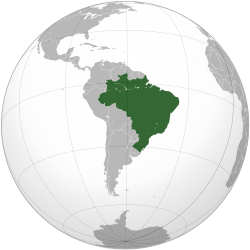Vargas Era
The Vargas Era (Portuguese: Era Vargas; Portuguese pronunciation: [ˈɛɾɐ ˈvaɾɡɐs]) is the period in the history of Brazil between 1930 and 1945, when the country was governed by President Getúlio Vargas.
Republic of the United States of Brazil (1930–1937) República dos Estados Unidos do Brasil United States of Brazil (1937–1946) Estados Unidos do Brasil | |||||||||
|---|---|---|---|---|---|---|---|---|---|
| 1930–1946 | |||||||||
| Motto: "Ordem e Progresso" "Order and Progress" | |||||||||
| Anthem: Hino Nacional Brasileiro (English: "Brazilian National Anthem") | |||||||||
 | |||||||||
| Capital | Rio de Janeiro | ||||||||
| Common languages | Portuguese | ||||||||
| Government | Provisional government (1930–1934) Representative democracy (1934–1937) Authoritarian dictatorship (1937–1945) | ||||||||
| President | |||||||||
• 1930 | Provisional Military Junta | ||||||||
• 1930–1945 | Getúlio Vargas | ||||||||
• 1945–1946 | José Linhares | ||||||||
| Historical era | Interwar period · World War II | ||||||||
| 3 October 1930 | |||||||||
| 16 July 1934 | |||||||||
| 23 November 1935 | |||||||||
| 10 November 1937 | |||||||||
| 22 August 1942 | |||||||||
| 24 October 1945 | |||||||||
• Deposition of Vargas | 29 October 1945 | ||||||||
| 18 September 1946 | |||||||||
| Currency | Brazilian real (1930–1942) Cruzeiro (1942–1946) | ||||||||
| |||||||||
Fall of the First Republic
changeThe First Brazilian Republic is the period of Brazilian history from 1889 to 1930. The Old Republic began with the deposition of Emperor Pedro II in 1889, and ended with the Brazilian Revolution of 1930 that installed Getúlio Vargas as a new president.
During this time, Brazil was affected by the Great Depression because the economy need foreign markets and loans. The limited industrial development in São Paulo, the export of coffee and other agricultural products were not enough to help the economy.
Second Republic
changeThe period from 1930 to 1937 is known as the Second Brazilian Republic, Vargas followed a path of social reformism in attempt to reconcile radically diverging interests of his supporters. His policies can best be described collectively as like those of fascist Italy under Mussolini, with an increased reliance on populism. Reflecting the influence of the tenentes, he even advocated a program of social welfare and reform similar to New Deal in the United States, prompting U.S. President Franklin Roosevelt to proudly refer to him as "one of two people who invented the New Deal."Vargas sought to bring Brazil out of the Great Depression through statist-interventionist policies. He satisfied the demands of the rapidly growing urban bourgeois groups, voiced by the new (to Brazil) mass-ideologies of populism and nationalism. Like Roosevelt, his first steps focused on economic stimulus, a program on which all factions could agree.
Third Republic (Estado Novo)
changeThe period from 1937 to 1945 is known as the Third Brazilian Republic, or Estado Novo. Vargas' four-year term as President under the 1934 Constitution was going to expire in 1938, however, Vargas managed to stay in power after the 1937 Brazilian coup d'état. Through this period, a series of measures were used to restrain political opposition, such as the nomination of Intervenors for the States and censorship of the media.

